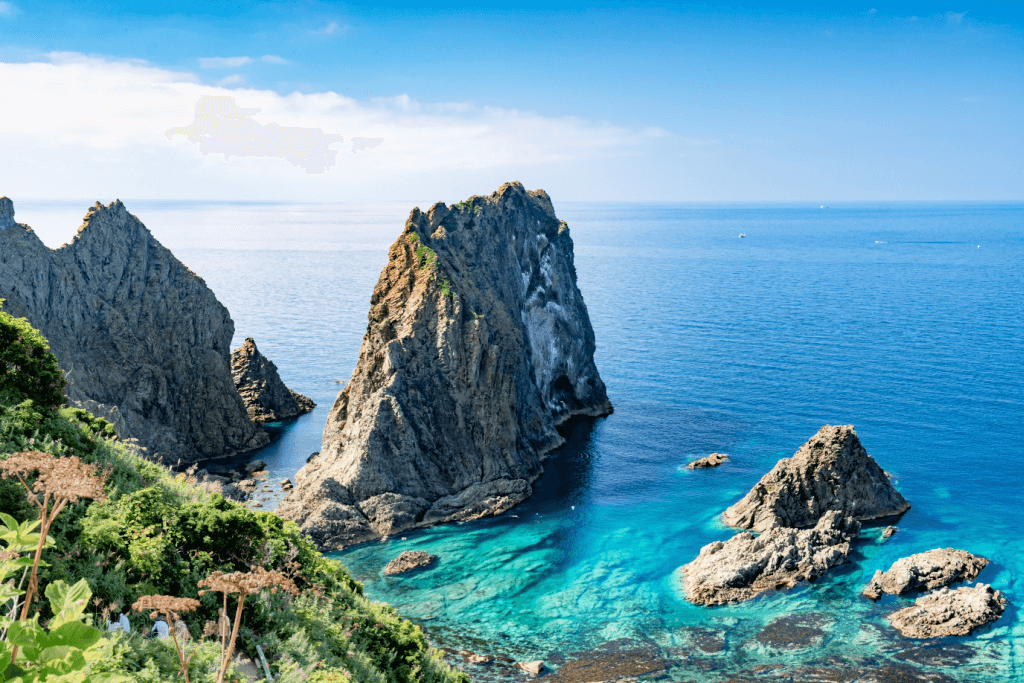Japan nature offers a sanctuary for those seeking solace and enchantment, from the rugged coastline and towering mountains to the tranquil forests and serene lakes. Visitors can explore hidden locations that showcase the country’s unparalleled beauty and immerse themselves in a world of unparalleled serenity. It’s a world away from the bustling cityscapes. Join us to discover the hidden gems of Japan’s natural landscapes and experience the tranquility and beauty that dwell beyond the cityscapes.
Table of Contents
ToggleCape Kamui (Shakotan, Hokkaido Prefecture)

Situated on the Shakotan Peninsula in Hokkaido, Cape Kamui is a testament to the raw beauty of Japan’s northernmost reaches. Cape Kamui is a haven for nature enthusiasts and those seeking a respite from urban life. It has windswept cliffs and panoramic views of the Sea of Japan. Moreover, the iconic lighthouse perches on the cape’s edge and stands as a silent guardian. It casts its beam across the rugged coastline. Overall, each visit to Cape Kamui is a communion with the elements because the wind whispers tales of untamed seas and untold adventures.
Izu Peninsula (Shizuoka Prefecture)

Venture south to the Izu Peninsula in Shizuoka Prefecture, where nature’s grandeur unfolds in a mountainous embrace. Izu Peninsula, famous for its hot springs, offers a unique blend of volcanic landscapes and therapeutic waters. Also, the towering peaks provide a stunning backdrop to the steam rising from hidden onsen retreats. Whether trekking through dense forests or relaxing in the restorative warmth of the region’s hot springs, Izu Peninsula invites those seeking a harmonious balance between mountainous beauty and soothing relaxation.
Hashiguiiwa Rocks (Kushimoto, Wakayama Prefecture)

Next, in the southern reaches of Wakayama Prefecture, the Hashiguiiwa Rocks stand as sentinels along the coastline, defying the relentless waves of the Pacific Ocean. Moreover, these coastal rock formations, shaped by centuries of tidal forces, create a mesmerizing landscape. As the sea crashes against the rocks, creating a symphony of nature’s power, visitors can stroll along the shore and enjoy the intricate beauty carved by the hands of time. All in all, Hashiguiiwa Rocks offer a captivating tableau of coastal resilience, a testament to the beauty between land and sea.
Angel Road (Tonosho, Kagawa Prefecture)
Nestled along the serene shores of Tonosho in Kagawa Prefecture, Angel Road is a captivating natural wonder, forming a sandbar connecting small islands during low tide. The term “Angel Road” also encapsulates the transient nature of this spectacle. This is because the sands create a transient masterpiece that unfolds and vanishes with the ebb and flow of tides. As the sun sets, casting a warm glow upon the sandbar, it undoubtedly becomes a canvas of vibrant hues, leaving an indelible impression on those fortunate enough to witness this magical interlude.

For locals and travelers, it is more than a geographical curiosity; it’s a living testament to the cyclical nature of life and the transient beauty that graces our world. Also, standing on this road means standing at the intersection of the tangible and intangible. The boundaries between earth and water blur, inviting all who venture there to become part of the ongoing narrative. As a result, it’s also a place where you can witness nature’s delicacies.
Are you looking to enjoy some snacks while in nature? Check out Sakuraco! Sakuraco delivers traditional Japanese snacks, teas, sweets, and snacks from local Japanese makers directly to your door so you can enjoy the latest treats directly from Japan!
Tojinbo Cliffs (Sakai, Fukui Prefecture)

The Tojinbo Cliffs rise dramatically from the Sea of Japan in Fukui Prefecture. They are a breathtaking display of nature’s sculptural artistry. Composed of hexagonal basalt columns, these cliffs are a geological marvel. The relentless forces of wind and sea also helped shape them. Tojinbo is more than a scenic vista; it’s also a place where the elements collide, and the result is a landscape that inspires awe and reverence. Visitors to Tojinbo Cliffs are, without a doubt, participants in a visual symphony written by the hand of nature.
Why should I visit Japan in nature?
The allure of Japan’s hidden natural locations lies in their ability to transport visitors into unparalleled serenity. Moreover, each destination offers a unique glimpse into the unspoiled beauty of Japan’s landscapes. Once again, these destinations are Cape Kamui, Izu Peninsula, Hashiguiwa Rocks, Angel Road, and Tojinbo Cliffs.

Visiting Japan in nature in its natural glory is an immersion into a world where time seems to stand still. It’s an opportunity to disconnect from the noise of modern life and reconnect with the timeless beauty that defines Japan’s untouched corners.
Have you ventured into these serene landscapes? Or do you dream of exploring the untouched beauty of Japan? Nature’s embrace in these hidden locations is a gift waiting to be unwrapped by every wanderer seeking a deeper connection with the Earth. Leave a comment below, and let the conversation flourish.











